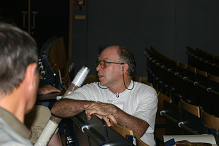
A short history of the Australasian Arachnological Society
by Tracey B. Churchill*

The Australasian Arachnological Society was formed in November 1979 by Robert Raven (photo left), when he was technical officer for Dr Valerie Todd-Davies, then curator of Arachnology at the Queensland Museum, Brisbane. Robert created the society's newsletter Australasian Arachnology. He managed the membership for a number of years and produced 24 issues of Australasian Arachnology overall, with various taxa depicted on the covers. He is now curator of Arachnology at the Queensland Museum, in Brisbane, and continues to be a supporter of the society.
In 1983, Richard Faulder, of Yanco Agricultural Institute, became administrator to manage the growing membership. Richard also assumed editorial responsibilities producing issues 10-20 of the newsletter whilst Robert Raven was overseas doing his post-doctoral research. Having returned from overseas in 1985, Robert Raven took up the editorial responsibilities again with issue 21 although Richard continued to print the newsletter.
In May 1986, the first meeting of Australasian arachnologists was held as a special symposium of the 17th Annual General Meeting of the Australian Entomological Society in Tunanda/South Australia. It was a great success. Twelve papers were presented, and eleven were published in a special proceedings volume in 1988: "Australian Arachnology" edited by Andy Austin and N. Heather. (The Australian Entomological Society Miscellaneous Publication No. 5).
In January 1989, Robert Raven produced his last issue of Australasian Arachnology, no. 35, before handing over to Mark Harvey, at the Western Australian Museum, Perth. Mark soon adopted his trademark cover picture of Nicodamus peregrinus, drawn by Graham Milledge. Newsletters continued to be produced by Mark with help from Julianne Waldock, until issue 54.
The 12th International Congress of Arachnology in Brisbane from the 12th to 18th July 1992 must, at the same time, be regarded as the second meeting of the Australasian Arachnological Society. The conference proceedings were published in the Memoirs of the Queensland Museum, volume 33(2) . This volume contains 46 papers on arachnology, 15 of which dealing with Australasian topics.
At the international arachnological meeting in Chicago in 1998, Mark offered Tracey Churchill, then with CSIRO in Darwin, the editorial position. From April 1999 to May 2004, Tracey produced issues 55-69 with cover pictures of a variety of taxa. She also introduced sections to cover student projects to encourage the growing interest in arachnid ecology at university level. Tracey was keen to see a website developed and an informal committee evolved with Volker Framenau and former editors of the society newsletter. At the international arachnological meeting in South Africa in 2001, former editors gathered to discuss the options for the next Australian meeting.
In June 2004, Volker Framenau, took on the editorial role of Australasian Arachnology from issue 70. Volker offered the newsletter as a pdf-version and was instrumental in getting the society website up and running in August 2005. To facilitate a national meeting Volker teamed up with Mariella Herberstein, Barry Richardson and Mark Harvey to introduce a special symposium, "Australasian Arachnology - Evolution, Ecology and Conservation", at the Combined Australian Entomological Society, Society of Australian Systematic Biologists and Invertebrate Biodiversity and Conservation Conference in December 2005, in Canberra.
In September 2009, Michael Rix, then at the Western Australian Museum, took on the role as newsletter editor. In May 2012, Cor Vink became webmaster of the AAS website. Michael is now at Queensland Museum.
In 2018 Robert Whyte, author of A Field Guide to Spiders of Australia, CSIRO Publishing 2017, and Helen Smith, Acting Technical Officer and Research Associate, Australian Museum, took on the responsibilities for the website, the newsletter, Australasian Arachnology and the Society's administration. An upgrade to the website and a newsletter are planned for completion by November 1 2018.
* Updated by Robert Whyte in 2018.

